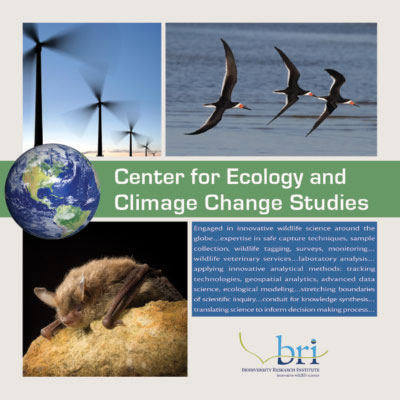Loon Research in Maine and New Hampshire
BRI biologists have been conducting loon research in Maine since 1994. Key projects include current monitoring efforts in the Rangeley Lakes area, including Lake Umbagog on the Maine-New Hampshire border, and establishing new breeding loon populations in portions of Massachusetts through the translocation of loon chicks from Maine and New York.
For more than 25 years, BRI has also conducted investigations in contaminant loads (e.g., mercury, lead, persistent organic pollutants), baseline health assessments, and other efforts to better understand Maine’s loon population. A total of 692 adult loons and 206 loon chicks have been banded in Maine and 102 (84 adult/18 chicks) have been recovered outside of their banding location (i.e., recoveries).
Contributing BRI Staff: David Evers, Bill Hanson. Download Status Report.
Featured Project : Evaluating lead and mercury exposure in adult Bald Eagles and Common Loons in Northeastern Maine
Current Status
Population
Maine’s current population estimate of adult loons is comprised of 1,700 territorial pairs, which is equivalent to 3,400 breeding adults and 700 nonbreeding (but oversummering) subadults and adults. This estimate is based on Maine Audubon’s ongoing monitoring and volunteer efforts in southern Maine coupled with random aerial surveys in northern Maine by the Maine Department of Inland Fisheries and Wildlife in the 1980s.

Seasonal Movements
Loons migrate from their breeding lakes to the ocean in the late fall. Maine’s proximity to the ocean allows loons to remain on their breeding grounds much later into the fall than their midcontinent counterparts. Adults depart before juveniles, thus young birds arrive on the ocean without guidance, prior knowledge, or experience. Band recoveries indicate that the majority of Maine loons overwinter along the coasts of Maine, Massachusetts, New Hampshire, and Rhode Island; however, individuals have been found south of Long Island, New York.
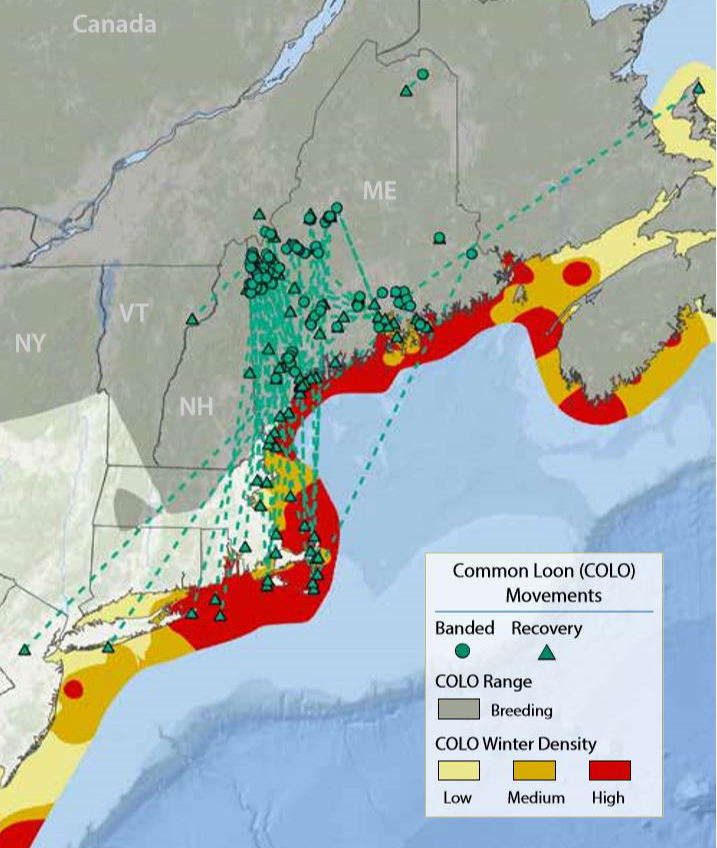
Rangeley Lakes
BRI’s Rangeley Lakes study is the longest running monitoring effort of a uniquely color-marked loon population in North America. Shoreline nest placement and the loon’s limited mobility on land make loon nests vulnerable to failure caused by water level fluctuations. Due to this sensitivity, the U.S. Fish and Wildlife Service (USFWS), the Maine Department of Inland Fisheries and Wildlife, and other wildlife agencies identified Common Loons as a species to be monitored in response to the Federal Energy Regulatory Commission (FERC) relicensing requirements for reservoirs.
Overall Study Goals
- Maintain nearly 80 artificial nesting rafts for Common Loons on reservoirs in the Rangeley Lakes region and monitor egg laying rates and hatching success.
- Capture and color-band adult and juvenile loons (373 adults and 111 chicks, for a total of 484 loons from this area have been banded to date).
- Monitor breeding territories on a weekly basis for overall breeding success, site fidelity, and individual performance of uniquely color-banded adult loons.
- Determine local and long-distance movements of breeding loons.
- Develop a long-term baseline for methylmercury availability and monitor the relationship of mercury body burdens and effects of mercury on physiology, behavior, productivity, and survival.
Site Fidelity in Western Maine
More than 200 territorial pairs of loons are annually monitored in the Rangeley Lakes Region. Surveys began in 1993; by the year 2000, the surveys fully covered the area (see figure below).
Researchers have also maintained a major, parallel effort to color band adult and juvenile loons each year. Re-observation of color-banded individuals provides important information about site and pair fidelity, local movements, migratory paths, and wintering areas.
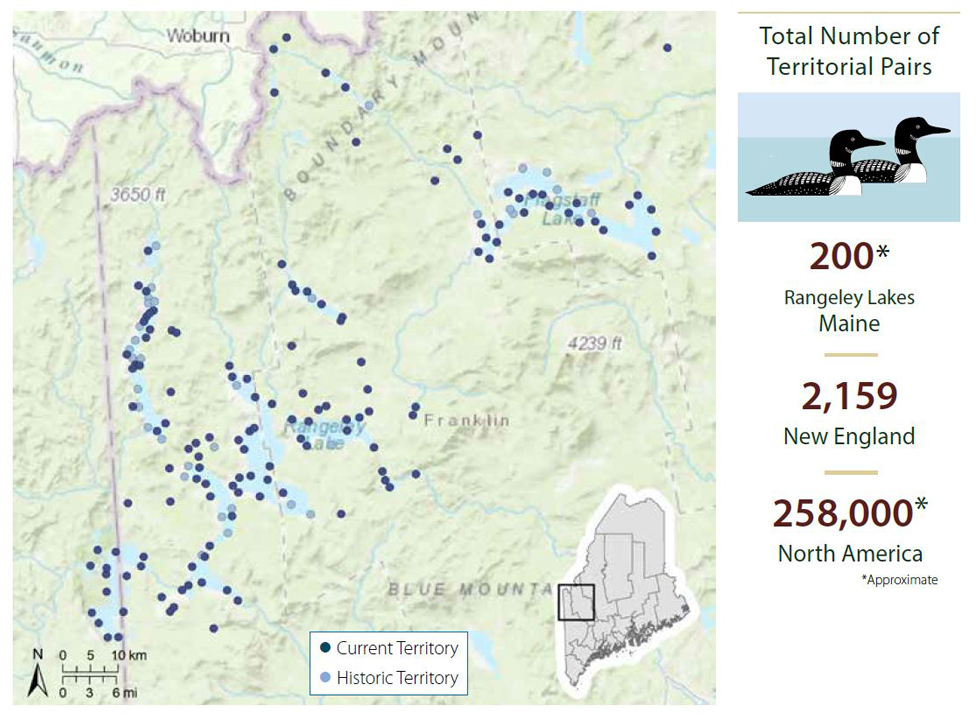
Nesting Rafts as Conservation Management Tool
The Federal Energy Regulatory Commission oversees the licensing of dams in the United States and issues new licenses every 20-25 years. The renewal of FERC licenses in the past decade has taken place within the context of negotiated settlement agreements arrived at by the dam licensees, state and federal agencies, and nongovernmental organizations. The International Joint Commission (IJC) plays a similar role to FERC for reservoirs that cross the U.S./Canadian border; Canada does not have a legal entity that corresponds to FERC.
Increased interest in recreational and environmental resources associated with these reservoirs, including breeding loons, has generated new considerations for reservoir management. Fluctuating water levels during the nesting season can have deleterious effects on loon nesting success. Increasing water levels easily inundate nests while lowering water levels strand nests, increasing the difficulty of incubation exchanges and enhancing predation (see figure below).
A study on three lakes in Voyageurs National Park (Rainy, Namakan, and Kabetogama Lakes) during the 1980s found an average of 60 to 70 percent of loon nests failed due to water level fluctuations. Based on a BRI-led study, the IJC in 2000 instituted new water level management guidelines for these water bodies in order to minimize the impact on loon nesting success, which is a good example for similar situations in Maine.
For the past 25 years, the FERC relicensing process has also implemented reservoir management schemes that minimize impacts to nesting loons in the Rangeley Lakes region. The general guidelines recommend maintaining water levels within a 6-inch rise and 12- inch drop during the primary loon nesting period, or the implementation of artificial loon nesting rafts to enhance nesting success.
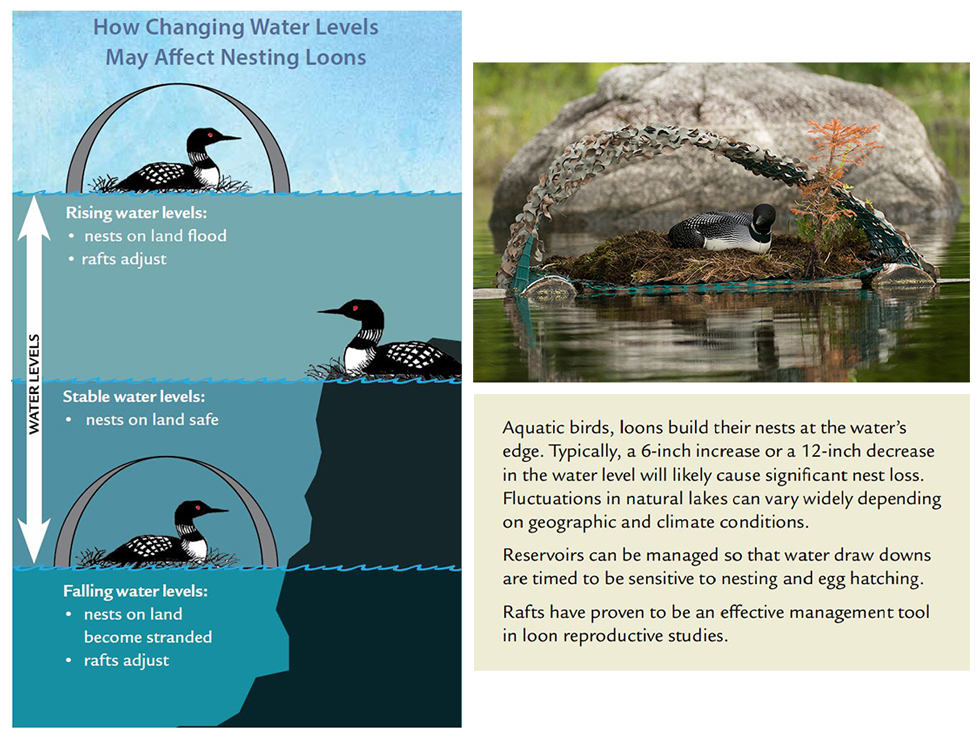
Translocation and Restoration
In 2015, in collaboration with the New York State Department of Environmental Conservation and the Massachusetts Division of Fisheries & Wildlife, BRI successfully moved seven chicks from New York’s Adirondack Park to a lake in the Assawompsett Pond Complex (APC) in southeastern Massachusetts.
In 2016, BRI translocated nine chicks to the APC (four from New York, five from Maine) with assistance from the Maine Department of Inland Fisheries & Wildlife and Maine Audubon Society. In 2017, eight Maine chicks were translocated to the APC site. Overall, 24 chicks were successfully translocated to Massachusetts.
As of summer 2020, nine adult loons (five of these from Maine) returned to the lakes in Massachusetts to which they were translocated and captive-reared, and then from which they fledged. Their return marks a major milestone in the efforts to translocate Common Loons. Of the two territorial pairs on site now, one pair produced a chick—the first in the region in over a century.
To learn more, see BRI publication: Loon Translocation: A Summary of Methods and Strategies for the Translocation of Common Loons
Marine Oil Spills
Bouchard Barge 120
On April 27, 2003, the Bouchard Barge 120 (B120) struck ground near Cape Cod Canal. Between 22,000 and 98,000 gallons of No. 6 fuel oil spilled into Buzzards Bay. This event occurred during migration of several bird species including the Common Loon. Approximately 200 dead or moribund loons were collected and a rapid field assessment was coordinated by the USFWS through the LPC and BRI to document the range and fate of dispersing individuals.
Oil Fingerprinting
Dispersed loons with oiled plumage were identified in Maine, Massachusetts, and New Hampshire. A total of five loons were observed with oil in Maine and New Hampshire. One of these loons was identified by its color bands and found on its traditional breeding territory in central New Hampshire.
Another loon captured in New Hampshire was tested and found to have been contaminated by the B120 oil spill. This finding and other observations documented that the “footprint” of impact was greater than the immediate Buzzards Bay area. Pre- and post-spill data from monitored breeding loon populations in the Northeast helped identify further potential impacts to reproductive success.
Proven Restoration Strategies
In a precedent-setting 10-year restoration effort for the North Cape Oil Spill in Rhode Island, BRI worked with the USFWS to identify and purchase the best lake shoreline properties for mitigation. We then monitored the protected loon pairs on a weekly basis for two to six years. This longterm approach was successful in replacing the 4,400 loon years lost (adult loons that died from the spill as well as their lost future progeny) through the long-term protection of 75 nesting pairs. This strategy was used for the B120 spill and settlement funds are now supporting a six-year project for BRI to restore breeding loons to southern and western Massachusetts with chicks originating from Maine and New York.
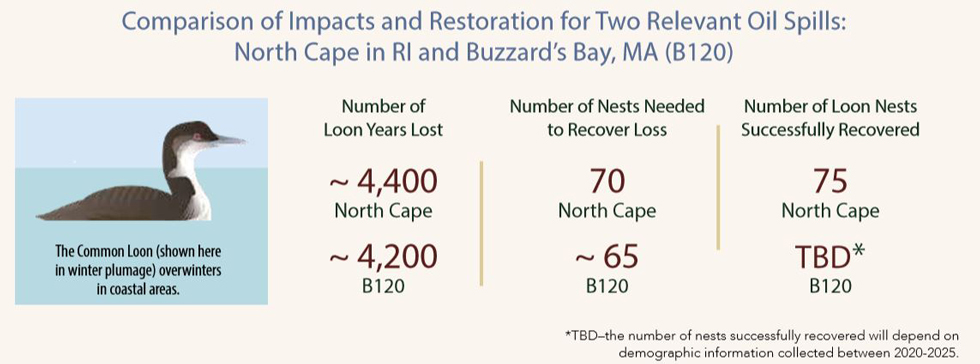
Next Steps
Evidence of the loon’s ability to acclimate suggests that properly designed conservation efforts can be beneficial in many instances (Evers 2007). BRI’s research has found the following actions to be successful or have potential for success:
Monitoring
A critical component of monitoring is to determine the cause of nest failure or chick loss. Standardized survey methods are used to collect data about the number of territorial pairs, nesting pairs, location of nests, chicks hatched, and chicks surviving beyond six weeks of age. BRI and Maine Audubon conduct such surveys in focused areas throughout Maine each summer.
Research
Research efforts track individual loons statewide. Through capture and banding, BRI biologists can determine mercury and lead body burdens. Research is conducted with the assistance of Maine Inland Fisheries & Wildlife.
Outreach
A variety of interactive outreach techniques, including exhibits, dioramas, school curricula, social media, and communication pieces (e.g. brochures, videos, and slide presentations, which can be available online), are utilized to create greater awareness of the presence and requirements of loons.
Restoration and Management Plans
Baseline data is utilized to create territory-specific restoration and management plans. Plans should include compensation measures for (1) the loss of nests by water level fluctuations or predation (i.e., nest platforms); (2) loss of nests/chicks from human disturbance (i.e., temporary closures); (3) adverse impacts from changes in prey or predator populations, such as Bald Eagles; and (4) the loss of territorial pairs (i.e., translocating loon chicks).

